Colorful, finely embroidered, and timeless. Those who think traditional Italian clothing is no longer a thing, are certainly wrong! In this article, we go in-dept and discuss traditional clothes in Italy and the fact that they still have an influence on the current Italian clothing culture.
Traditional Italian clothing
Traditional Italian clothes have evolved throughout history and experienced their greatest developments during the Renaissance (around the 15th century AD). In fact, it was during this period that Italy broke away from French fashion and developed its own style, becoming one of the most important exponents of clothing in Europe.
The main reason for this breakthrough was that new textiles began to be produced in the Italian territory, in particular in cities such as Florence, Venice, and Milan. This led in turn to the emergence of new and colorful styles of clothing that better represented the country’s culture and spirit.
This content is not shown.
Click on this block to display all our content, by accepting our cookies or review our cooky-policy below.
Traditional fashion and brands
Typical Italian clothes have not disappeared at all: some people still jealously conserve them, to bring them out on special occasions, such as folkloric events, religious celebrations, and countryside festivals, and also, let’s be honest, to attract tourists.
Important to note: there’s no single traditional Italian dress: different Italian regions have different typical dresses, that reflect both their own traditions and culture, as well as their specific climate conditions.
Today, Italy is still home to several of the most important clothing brands in the world, and Italian clothes are still synonymous with quality, elegance, and refinement. This is certainly a heritage of all these years of textile tradition, that helped to shape the Italian style and culture around clothing.

Furthermore, Italian designers and stylists are still drawing inspiration from traditional Italian dresses. For example, Dolce and Gabbana have made Italian, and prominently, Sicilian, baroque themes one of the trademarks of their brand.
This content is not shown.
Click on this block to display all our content, by accepting our cookies or review our cooky-policy below.
Also read: Italian fashion house Gucci is so well known, that an American movie was made about it. Read more about House of Gucci movie locations in Milan and Rome used by a top cast (Lady Gaga, Al Pacino).
Italian culture and clothing
This is why learning more about the Italian clothing culture, allows having a deeper understanding of the Bel Paese’s culture, its popular roots, and the differences between its regions. Traditional Italian costume tells also the story of the different eras that have shaped the Peninsula, of all the cultural influences brought about by external domination.
Finally, and perhaps more importantly, clothing illustrates the growth of Italian national identity. Indeed, when talking about Italian traditional dresses, it is essential to keep in mind that Italy is quite a young country and that the different lands that merged some 150 years ago all brought different traditions and costumes into the formation of the Italianity as we all know it today.
Different regions, different clothing
Indeed, from the typical dresses worn at the border with Austria to the traditional Sicilian clothes, almost every region has its own particular dress, with its own colors and fashions, special shoes, and hats. These differences are not only a result of different cultural backgrounds, but also of the different climates in the Peninsula, which is reflected in the choice of specific materials and fabrics that can best accommodate them.
In addition, it is also possible to find different clothes associated with different religious celebrations or festivities. Think for example of the traditional Venetian Carnival costumes worn by characters such as Arlecchino, Columbina, and Pantalone (we will talk more about this later).
This content is not shown.
Click on this block to display all our content, by accepting our cookies or review our cooky-policy below.
However, in spite of all these differences, it is possible to find some commonalities in traditional Italian clothing. Let’s discover them.
The traditional Italian female dress
The traditional Italian dress is generally characterized by colorful embroidered skirts and bodices over lightweight chemises or blouses. Hair accessories and headwears are also very common, as well as elaborate hats decorated with flowers or fruit. Veils are also very common, particularly in the South: after all, we must not forget the importance of religion in the country, especially in the past.
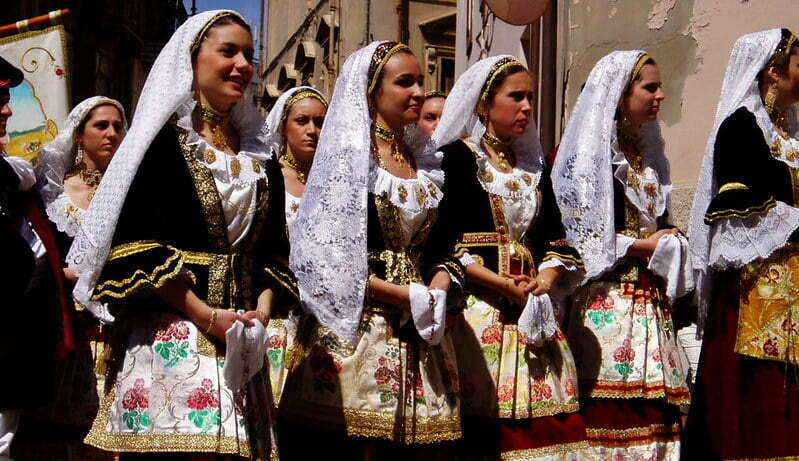
As far as the materials are concerned, wool, hemp, linen, and -more infrequently silk- are the most used ones. Relatively cheaper materials are also a testimony to the popular origins of most traditional dresses.
Another proof of the peasant origins of these dresses can be found in the fact that most women’s hats have a flat top. The reason is that these hats helped the women carry baskets to market…certainly not an upper-class activity.
This content is not shown.
Click on this block to display all our content, by accepting our cookies or review our cooky-policy below.
On the other hand, the clothes worn by wealthy Italian women were made of richer fabrics like silk and velvet, with a wider color palette than the peasants’ ones. Upper-class Italian women also tended to wear more jewelry than peasants.
Traditional Italian male clothing
Male traditional clothing is generally more simple and streamlined than women’s. However, this doesn’t mean that the details are neglected. Embroidery and metal buttons and pins are widely used also aside from their original function: indeed, the different ways in which they had been decorated were often associated with the different geographical provenience, and even the class or family, of the people wearing them.
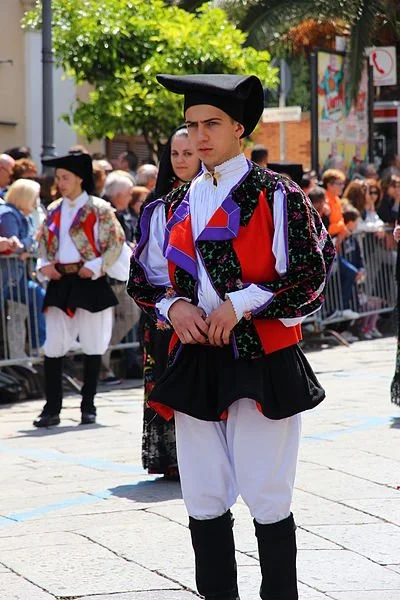
Trousers, blouses, and suspenders are generally common in all the different male clothes, with regional differences when it comes to the different motives and details printed on them, and the different types of hats worn by people from different social statuses, and different regions, in the North they were mostly used to protect from the cold, while in the South to take shelter from the sun, hence the different shapes and materials.
This content is not shown.
Click on this block to display all our content, by accepting our cookies or review our cooky-policy below.
Even in this case, peasants wore items made from simple fabrics, with wool being very common in the North of the country, and hemp in the South. Upper and middle-class men’s clothes were generally more embroidered and embellished with pins, chains, and buttons.
Now that we have a general idea about what traditional Italian dresses looked like, let’s see more in detail some specific regional examples.
Traditional Italian clothing: some regional examples
The regional variances of traditional Italian dresses are almost endless! Just think about the fact that every village can have its own, unique traditional costumes. Therefore, in this short overview, you will find some of the most characteristic ones, divided by macro-regions.
1. Alto Adige/ South-Tyrol: Tracht, Dirndl and Sarner
The traditional South Tyrolean costume is called Tracht and was predominantly worn on festive days to indicate belonging to a village, valley, or certain territory. These clothes were carefully and artistically crafted: linen, leather, lace, and colorful bands embellished the traditional South Tyrolean costumes.
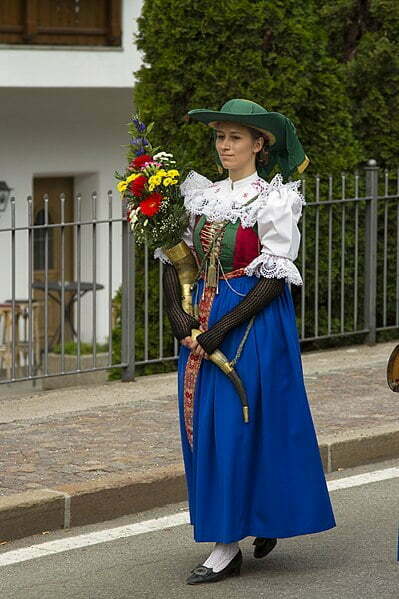
This content is not shown.
Click on this block to display all our content, by accepting our cookies or review our cooky-policy below.
Women’s traditional clothing is called Dirndl, which consists of a guêpière, a blouse, a wide skirt, and an apron, decorated with accessories, such as scarves or vests. A peculiarity here is the position of the bow: if the bow was worn on the left, the woman is single; if it was tied on the right, the woman was engaged or recently married.
Men, on the other hand, proudly wore the Fatsch, a leather belt often richly adorned with embroidery. Also, men wore the traditional, durable Lederhosen (traditional short or knee-length pants made of leather with suspenders), with different aprons and socks that indicated different territorial affiliations.
Sarner is another typical piece of clothing for men. It is a round-necked cardigan, manufactured from some boiled wool with colored borders, traditionally sewed by hand by the local community. Over time, buttons of different materials, including bone, horn, and wood, have been added to the traditional fabric.
2. Sardinia: colorful and finely embroidered
Let’s move now to the beautiful Sardinia. The Sardinian traditional costume was used not only as a way of communicating the origins of the wearer -each village has its own characteristic dress- but it also revealed their extraction and social status.
This content is not shown.
Click on this block to display all our content, by accepting our cookies or review our cooky-policy below.
Each costume is, therefore, a piece in itself: there are costumes for men and for women, for festivals and for every day, for the rich and for the poor, for shepherds and for fishermen, for married women, for single women, and for widows.
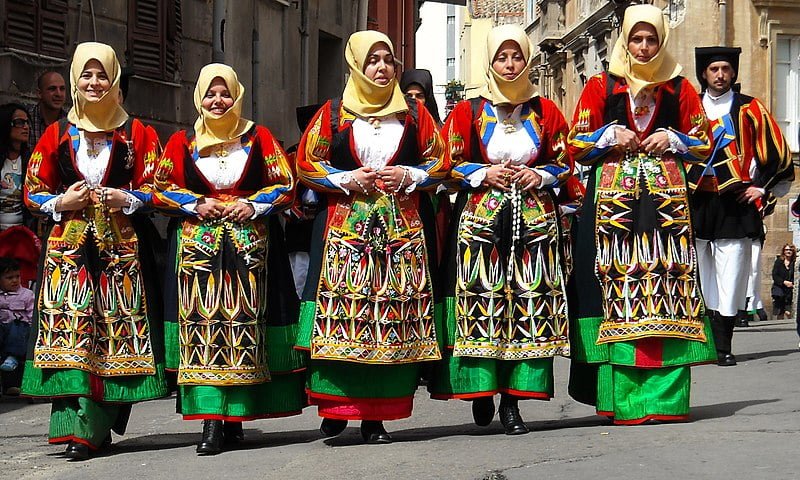
More specifically, women’s traditional dress consists of a cap, which can be either a shawl, veil, or a cape; a white puff-sleeved shirt; and a corset, which can be made of different fabrics and colors and is then finely pleated and sewn. Gold and silver jewelry, with coral and pearls, are then used as decoration.
On the other hand, male dresses are generally a cap, a shirt or vest, a jacket, and the ragas, i.e. white linen pants. On colder months, men used to wear the characteristic gabbanu, a wool cloak proper to the pastoral tradition.
3. Sicily: colorful handkerchiefs and long skirts
Let’s move now to the other big Italian island, Sicily. Here, traditional clothing has been deeply influenced by the rural nature of the territory and is therefore quite simple and practical.
This content is not shown.
Click on this block to display all our content, by accepting our cookies or review our cooky-policy below.
Indeed, the typical Sicilian women’s dress is definitely one consisting of a simple skirt of linen, cotton, or lamé that was called a fadedda. Long to the feet, this garment was stopped at the waist with a belt and paired with a petticoat and a jippuni, a heavy blouse made of the same fabric. To add color to the dress, a handkerchief was placed on the shoulders. The skirt was also paired with a simple apron, and finally, the outfit was ended with blue stockings and classic black shoes.
Often and frequently, women completed their outfits with a cape to be placed over their shoulders. It was a universal garment, worn by Sicilian women to go into the market or into town to run errands for the household. On the other hand, when it was necessary to attend church, for example during processions, women used to combine their everyday garments with a faddigghia, a black silk overcoat that went down from the waist to the feet, which was a more refined piece dedicated to the great occasions.
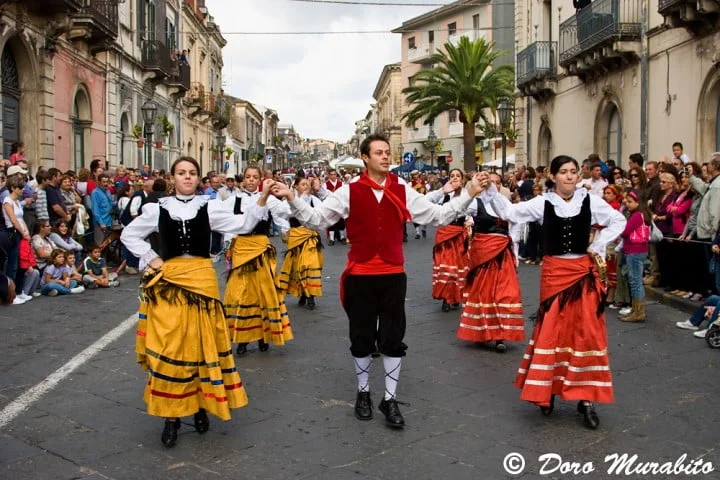
On the other hand, men were more simply dressed in causi, velvet pants tightened with buckles at the knee level, with openings on the hips, which were then paired with a green or light blue waist belt, and a panzera with brass buttons. Completing the men’s outfit was the coppola, the traditional brown cloth cap.
This content is not shown.
Click on this block to display all our content, by accepting our cookies or review our cooky-policy below.
4. Lazio, Abruzzo and Molise: the Ciocia footwear
This traditional footwear from the central and southern regions of Italy gave its name to Ciociaria, the characteristic rural area famous for the homonymous movie with Sofia Loren.
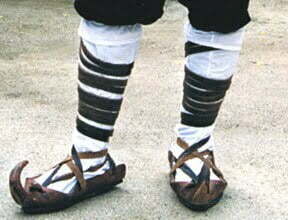
Ciocia were the typical shoes of peasants and shepherds, consisting of wide soles of treated leather that were then wrapped around the foot and anchored to the leg with some straps. Ciocia is often matched with the so-called pezze, a band of white fabric that completely wraps around the foot, ankle, and calf.
Nowadays, it is possible to see them on the feet of pipers at folklore events, where typical Italian costumes are still worn, or outside restaurants and bars, as a tourist attraction.
5. Venice: the precious Carnival costumes
What better way to end this overview than with the Venetian Carnival costumes? These rich and opulent dresses, reminiscent of the glorious splendor of the Serenissima, are still nowadays made with skill and precision by specialized ateliers, to celebrate the famous Venetian carnival.
This content is not shown.
Click on this block to display all our content, by accepting our cookies or review our cooky-policy below.
The tradition to wear these elaborated dresses started back in the XVth century when upper-class gentlemen started some entertainment clubs Compagnie della Calza, whose purpose was to organize parties and celebrate the artistic and cultural ferment of the city.
Venetian costumes for women consisted of tight bodices stiffened by whalebone splints, while the skirts were sinuously wide thanks to ingenious internal supports. Made of precious fabrics and silks that came to the Lagoon from the distant lands of the East, they were always embellished with Burano glass. On the feet were tall shoes that could reach up to 50 centimeters in height, called calcagnini or ciopine.
Except for carnival, Venice has much more to offer. We have selected nine authentic must-do’s.
To complete the outfit there were the accessories, which were very important: mittens, handbags, and folding fans, indispensable for visual communication, and true weapon of seduction at the time.
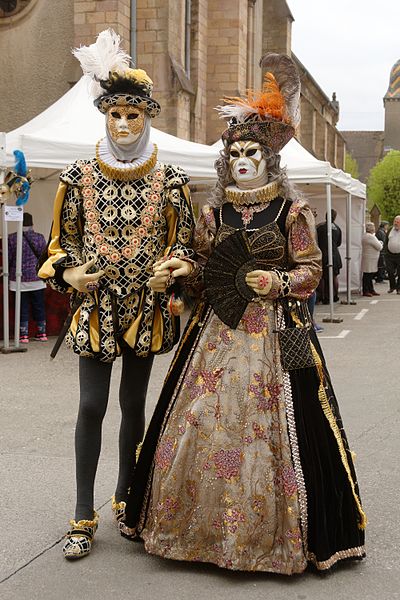
Men were also dressed in clothes made of fabrics from the Orient, such as velvet and damask. Their clothing was usually made of a tailcoat, a shirt that was always white, and short pants tight just below the knees. A headdress and a long black cloak, made of silk or wool, completed the outfit.
This content is not shown.
Click on this block to display all our content, by accepting our cookies or review our cooky-policy below.
In conclusion…
Traditional Italian dresses are real “pieces of wearable history”, as they faithfully narrate the story of the evolution and unification of this beautiful country, as well as the regional differences that still co-exist today in Italian culture.
Every region, every occasion, and even every village and family have its own traditional dresses, which are still used to celebrate special occasions, and -perhaps most importantly- to keep the past alive!
Q&A on traditional Italian clothing
Where do the most important styles of traditional Italian clothing come from?
You find especially strong traditional dress style in South Tyrol (Alto Adige), Sardinia, Sicily, Venice and the region south of Rome.
Also read:
- Christmas in Italy: guide on food, traditions & destinations
- Venice Film Festival 2022: Italian films not to miss
- Facts about pizza: 20 interesting unknown pizza facts
This content is not shown.
Click on this block to display all our content, by accepting our cookies or review our cooky-policy below.

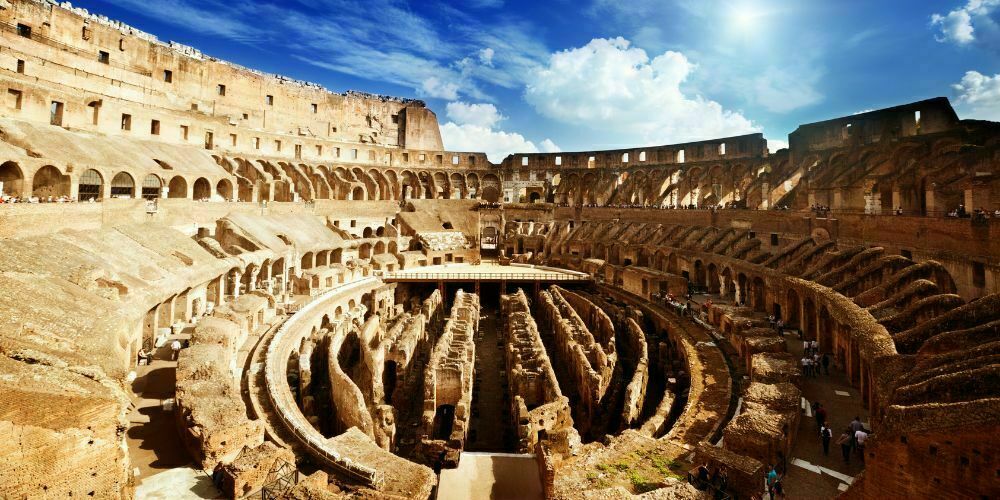
Hello,
I’m visiting my home town of Sezze Latina on sept 14. Where can I get a traditional folk dress closest to me?
Thank you so much
Ciao